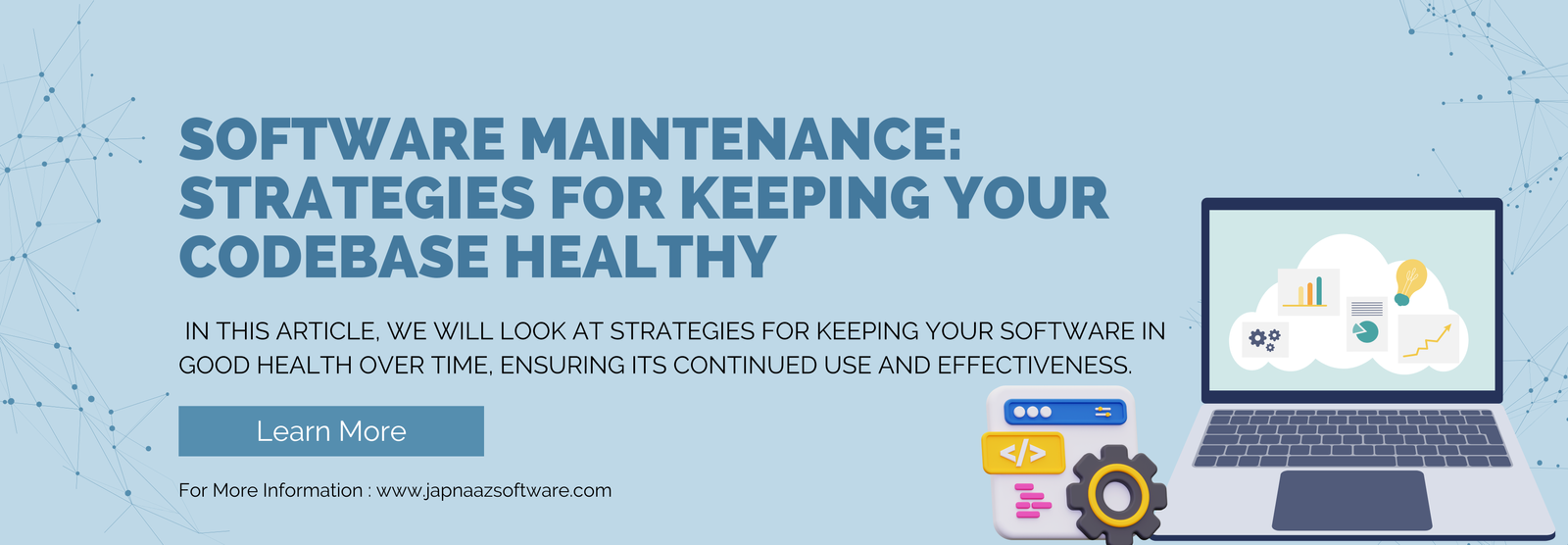
Software maintenance frequently takes a backseat to the excitement of development in the fast-paced world of technology. Neglecting your codebase's ongoing maintenance, however, can result in a number of problems, such as worse performance, more security flaws, and more technical debt. In this article, we will look at strategies for keeping your software in good health over time, ensuring its continued use and effectiveness. These strategies are in line with the ideas of adaptive software development and include initiative to handle changing requirements and environmental changes.
Regular Updates and Patch Management: Keeping up with updates and fixes is one of the most important parts of software maintenance. Bug fixes, performance improvements, and important security updates are frequently included in these updates. By creating a regular update and patch management schedule, you can make sure that your codebase performs at its best and is resistant to new threats.
Code Refactoring and Optimization: Software code can grow bloated, inefficient, and challenging to maintain over time. Your codebase will become more manageable and easier to work with with regular code refactoring and optimization. You can improve your software's overall performance and scalability by removing unnecessary code, refining algorithms, and streamlining database queries. These procedures are especially important for software development agency because they help them provide their clients with high-quality solutions that are both efficient and affordable.
Continuous Integration and Automated Testing: These two strategies can greatly increase the software's stability and dependability. While continuous integration makes sure that changes to the codebase are integrated easily and without interruption, automated tests aid in the early detection of bugs during the development process. You can decrease the chance of introducing regressions and the amount of time spent on manual testing by automating these procedures.
Documentation and Knowledge Sharing: Especially in large and complex projects, thorough documentation is crucial to maintaining a healthy codebase. Code structure, APIs, and business logic documentation speed up the onboarding process for new developers and promote knowledge exchange within the team. Keeping documentation current also makes it easier for developers to comprehend and make changes to already-written code, which lowers the possibility of mistakes being introduced during maintenance.
Performance Optimization and Monitoring: By keeping an eye on your software's performance in real-time, you may spot possible bottlenecks and take action before they negatively affect users. Metrics like error rates, resource usage, and response times can be analyzed to identify areas for improvement and optimize your software for optimal performance. Your application can stay responsive and scalable even as usage patterns change if you use performance monitoring tools and routinely profile its performance. These procedures are necessary for full stack web development projects, as providing a smooth user experience throughout the application stack depends on optimizing both the front-end and back-end components.
Security Audits and Vulnerability Scans: Conducting regular security audits and vulnerability scans is crucial for identifying and addressing potential security risks in your codebase. By proactively assessing your software for vulnerabilities such as injection attacks, cross-site scripting (XSS), and authentication flaws, you can mitigate security threats before they can be exploited by malicious actors. Implementing automated security scanning tools and staying informed about the latest security best practices can help strengthen the security posture of your software.
Version Control and Change Management: By utilizing version control systems like Git, you may efficiently work with team members and monitor changes made to your codebase over time. You can help developers collaborate while keeping your codebase tidy and orderly by adhering to best practices for branching, merging, and code reviews. Furthermore, putting in place a strong change management procedure makes sure that any changes made to the codebase are carefully tested and recorded before being put into use in production settings.
Error Logging and Monitoring: It's essential to keep track of and record any faults that arise in your software in order to discover and diagnose problems that can impair its functionality and dependability. You may record comprehensive information about errors, such as stack traces, error messages, and contextual information, by putting strong error logging methods in place. You can proactively detect recurring issues and prioritize their solutions by examining error logs and tracking patterns over time. This will increase the overall stability of your product.
Planning for scalability and managing capacity: Long-term success depends on projecting future expansion and making sure your software can grow to meet rising demand. You can find possible scalability constraints and distribute resources appropriately by doing capacity planning exercises and scalability evaluations. You can make sure that your software stays responsive and robust as user traffic increases by making the most of cloud infrastructure, maximizing resource consumption, and putting horizontal scaling ideas into practice.
User Feedback and Iterative Improvement: By integrating user feedback into the maintenance procedure, you may identify and prioritize features that will have the biggest effects on user satisfaction. By using feedback systems like user forums, surveys, and customer service channels, you may collect important information regarding feature requests, usability problems, and user preferences. You may improve your software's relevance, usability, and overall value proposition by iteratively making changes based on user feedback.
In conclusion: Maintaining your codebase successfully and sustainably over the long run depends on effective software maintenance. You can maintain the health, resilience, and suitability of your software for years to come by adhering to the practices discussed in this article, which include automated testing, documentation, performance monitoring, code reworking, and frequent updates. These procedures are especially important for software development company because their goal is to provide their clients with high-quality solutions while upholding the integrity and dependability of their codebase.